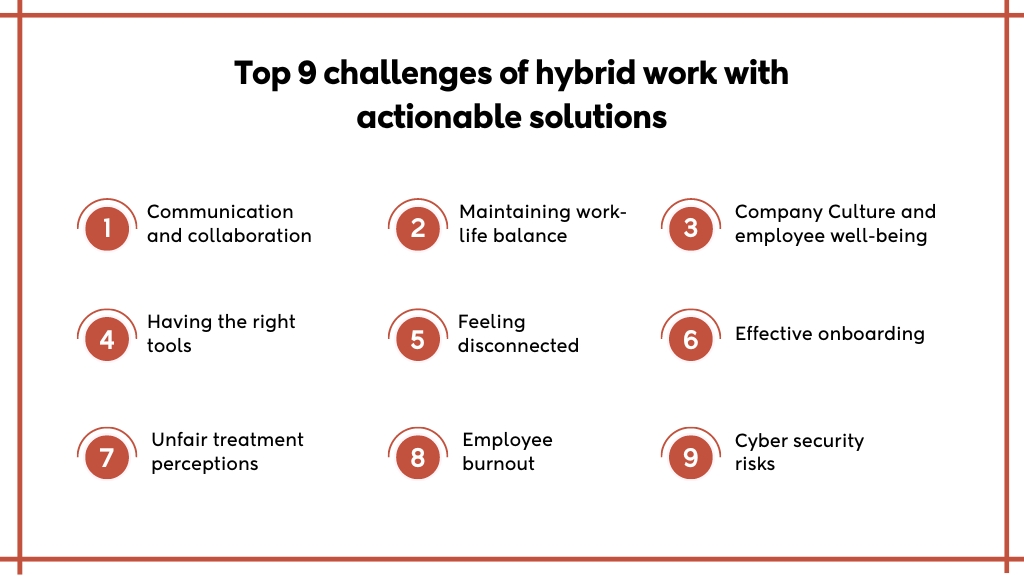Introduction
The traditional office is evolving. Hybrid work models, blending remote and in-person work, are gaining traction. While exciting, this shift presents unique challenges.
Imagine leading a brainstorming session with a split team – some in the conference room, others joining virtually.
Or, picture struggling to stay focused with the couch and laundry mere steps away. These are just a glimpse of the hurdles hybrid work can bring.
Here’s the good news: this guide equips you with the knowledge and strategies to conquer these challenges. We’ll explore the 9 most common obstacles faced by hybrid teams, from fostering company culture to maintaining work-life balance.
Along the way, you’ll discover actionable solutions and best practices to ensure a successful hybrid work experience for everyone. So, whether you’re an employer or employee navigating this new landscape, keep reading and unlock the full potential of hybrid work!
Top 9 challenges of hybrid work with actionable solutions

By Gallup, the greatest challenges of hybrid work include: having the right tools to be effective at work, feeling less connected to the organization’s culture, impaired collaboration and relationships, and disrupted work processes.
Let’s dive into these challenges and more. Also, explore actionable solutions to keep your hybrid team thriving.
1. Communication and collaboration
No matter your industry or workforce size, communication and collaboration breakdowns are almost unavoidable. Hybrid teams are more likely to experience a communication gap that can hinder the cooperation process between team members.
A hybrid work environment, where some team members work remotely and others are in the office, can lead to clashes in communication styles. Information flow can get disrupted, hindering collaboration and team cohesion. Remote workers might feel left out of important discussions. Working remotely can make it difficult to build rapport with colleagues you rarely see in person
Solutions
- Embrace the right tools: Invest in a suite of communication tools that cater to different needs. Utilize project management platforms like ProofHub for task organization and updates, instant messaging for quick communication, and video conferencing tools for virtual meetings.
- Schedule regular virtual meetings: Schedule regular team-wide meetings and smaller group meetings to ensure consistent communication and information flow.
- Practice asynchronous communication: Encourage asynchronous communication tools like emails, discussion boards, and document collaboration platforms for ongoing discussions and updates that don’t require everyone to be online simultaneously.
- Establish clear communication guidelines: Set clear expectations for communication methods and response times for both in-office and remote teams.
Read More: Struggling with Remote Team Engagement? Discover 8 Proven Habits for Success in 2024
2) Maintaining work-life balance
Managers should make their team members aware of the signs of stress which can include fatigue, poor sleep, body aches, and unpleasant sentiments about work. So, create small objectives that can help to avoid stress.
If you develop a culture of gratitude, then team members can celebrate small milestones leading to larger objectives. As a manager, it becomes your responsibility to schedule breaks, exercise, naps, or to make your employees engage in some other daily routine that distinguishes working time from the rest of the day, therefore assisting in overcoming the stress.
Read More: Boost productivity & well-being with proven work-life balance strategies.
3) Company Culture and employee well-being
Challenges of hybrid working can also include company culture as there is little or no face-to-face contact between employees working in a hybrid working model.
Employers can help in encouraging team bonding through virtual activities like participation in online fitness classes as a team or also eating meals together over online channels like Zoom or Skype. Organizations can also set fun challenges for their employees. This brings the team together and fosters friendship.
Challenges of hybrid working have also been linked to a decline in physical and mental health, according to research published in the Journal of Occupational and Environmental Medicine.
In order to tackle this problem, managers must let their employees speak with each other freely and employees should have a regular schedule that includes the right time for exercise, work, eating as well as resting.
Meditation can benefit employees in several ways. It can enhance their focus on work activities, help them recover from screen fatigue, and even contribute to improved mental health. Also, by implementing a comprehensive remote employee wellness program, you can cultivate a healthier, happier, and more productive remote workforce.
Read More: Learn effective strategies for building and nurturing a positive organizational culture.
4) Having the right tools
A hybrid work model, where team members aren’t always physically together, can lead to communication and coordination challenges. For example, consider the following scenario:
- Not everyone can get or respond to emails at the same time
- You have to write emails back and forth, which consumes time.
- It becomes hard for team members to communicate regarding their day-to-day tasks
Without the right tools, communication, collaboration, project management, and overall workflow management can become cumbersome in a hybrid environment.
Invest in a comprehensive suite of tools specifically designed for hybrid work. Consider project management tools with features like task management, communication channels, file sharing, and progress tracking.
Explore collaboration tools that facilitate real-time document editing, brainstorming sessions, and video conferencing. Implement time management tools that help both remote and in-office employees track their work hours and optimize their schedules.
5) Feeling disconnected
The problem is that not everyone can work remotely, thus they might miss out on the advantages of hybrid working. This is a problem in organizations employing frontline workers, who could believe they are performing the hard tasks while at the same time their desk-bound colleagues enjoy at home.
On the other hand, employees working remotely can feel left out of discussions and decisions since they aren’t physically there. So as a result, it can make them feel neglected and underappreciated among their co-workers.
What you can do as a manager is that you provide opportunities for everyone, irrespective of where they work, to grow and be recognized. All through the organization, relationships must be developed equally. This way your employees will feel valued.
As we know building relationships is a very personal thing, but technology can play an important role. You can invest in tools that allow remote, office-based, and frontline personnel to communicate seamlessly daily.
6) Effective onboarding
Regardless of how well-intentioned a business is, the onboarding procedure may be daunting for new starters, especially if they have remote teams. Seeking to integrate a new employee into your corporate structure and getting them up and running quickly on internal procedures might take a long time if they divide their time between home and office.
Effective onboarding has various advantages that can also include enhanced engagement levels, less time spent on learning the work, and lower staff turnover.
Managers and leaders must devise new approaches to make their onboarding processes work in a hybrid environment.
Emphasize personal relationships through one-on-one introductions, foster a culture of cooperation and feedback, and encourage new hires to participate in non-work-related conversations and activities.
Understand that onboarding isn’t simply a manager’s duty; it’s a smart option to include the entire team, breaking down barriers and setting the framework for sustainable relationships.
Read More: The ultimate guide to onboarding remote employees!
7) Unfair treatment perceptions
Leading teams across various locations can be one of the critical challenges of hybrid working, especially when it comes to ensuring that employees have equal opportunities. Remote employees might sometimes feel that they get less recognition at work than those working from the office.
Structured goals and targets provide employees with a feeling of purpose at work, allowing them to comprehend their performance and inspiring them to strive for themselves further. Leaders should meet with all of their staff frequently for check-ins and casual catch-ups. Not just to collaborate on daily tasks, but also to offer professional growth advice.
8) Employee burnout
One disadvantage of working remotely for some people is that there are fewer limits. Staff who work from home might feel compelled to be on call more frequently and work longer hours than those who work in an office. Though this may imply that workers get more done, it also might indicate that the quality of their work suffers.
As a result, this not only makes employees suffer from lower quality of work or productivity, but if they leave the job, organizations must spend their additional resources, time, and money to train new employees.
Managers can set clear and simple expectations of when employees are expected to be available and when they are expected to be offline. This way organizations will be capable of building a healthy working atmosphere. They will also help them to draw new talented employees towards their organization and boost employee retention.
Read More: Learn how to manage stress in a remote work environment at workplace.
9) Cyber security risks
As remote team members work out of sight, the chances of a security breach increase dramatically. The hybrid staff can utilize their own PCs.
Employees’ private computers are mostly out of corporate network and endpoint security measures. The network and data of a corporation can only be as safe as its most vulnerable computer configuration. All remote workers must fulfill security criteria, according to the organization.
Organizations should place strict security measures to protect themselves from those security threats. While implementing other security measures, you must also use a tool that takes data protection seriously.
Choosing a secured work management software can help you achieve this level of security. The tool should guarantee that any information saved is completely secure. It should employ cutting-edge technology to maintain stringent data security standards. It should ensure personal information is secured, and communications and business data are streamlined.
Conclusion
The hybrid work model is gaining traction across businesses, but many are overlooking the potential challenges it presents. Usually, these hybrid work problems stem from the requirement to ensure consistency for all employees, regardless of whether they’re in the office or working remotely.
As a result, it’s critical to comprehend the work challenges you may experience while managing a dispersed team. You can then figure out how to address these issues so that implementing this new method of work succeeds rather than fails.
Keep checking back for the latest news and information to help you excel at work.


















No Comments